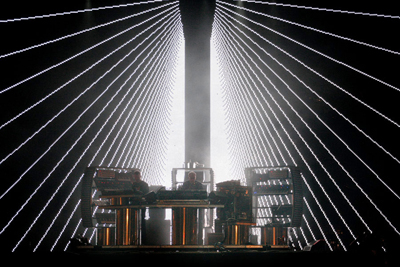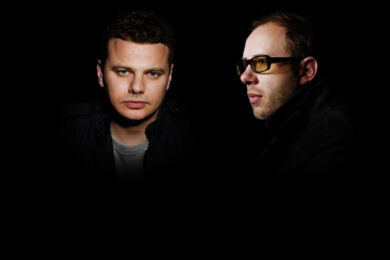Dance music ages in dog years due to the hyper acceleration of club culture, an inbuilt fascination with obsolescence and novelty and a need for DJs to stay ahead of one another. This means The Chemical Brothers should probably be considered The Rolling Stones of house now that they’re celebrating their 15th birthday. Their regular night Naked Under Leather in Manchester (and later, an early doors Heavenly Social at The Albany in London) cemented their love for punishing acid house, hip hop breaks and rock dynamics while they were still The Dust Brothers. (This showed an admirable lack of ambition – it never occurred to them that it would ever be problematic that they had the same name as the production duo who oversaw the Beastie Boys’ Paul’s Boutique.) While it’s questionable as to how much we actually need another Chems comp – there was one released in 2003 – this does serve as a reminder, if one were needed, how great they are. Below, the brothers Ed Simons and Tom Rowlands, are gonna blurt it out.
1. ‘Song To The Siren’ was made on a home stereo
Ed: That record made an impact. I suppose it was a lot slower than a lot of stuff going on at the time and it was based on breaks rather than a four-to-the-floor beat. It was a very odd-sounding record. You had people like Andrew Weatherall playing it.
Tom: We had our own club night called Naked Under Leather and we’d always be looking for extended instrumental tracks of hip hop releases and we’d be playing stuff by Meat Beat Manifesto and Renegade Soundwave and lots of techno. Basically we wanted to make a record that would be the ultimate reflection of our DJing. We made this in my bedroom on my little hi-fi. It sounded like techno meets hip hop meets psychedelia. We were living in Longsight in Manchester at the time and once when we got in from a night out, someone had stolen the floor. We used to have stone flags down in our basement and someone had broken in and taken them and there was just earth left. Whenever we had parties they were just really muddy.
2. ‘Come Home’ needed to happen
Ed: It sounded like something that people wanted to exist. It was almost obvious to have this record with all the dynamics of an acid house track with all the rises and drops mixed, coupled with a funky breakbeat groove.
Tom: We used computers and drum machines and stuff but we wanted it to sound like a band and there was some kind of sweat and energy going on.
3. We didn’t mind the big beat tag
Ed: I didn’t mind at all. The first EP we put out with ‘Chemical Beats’ had a track that was the closest we’ve done to a trip hop record. I thought trip hop was a cooler name and made me think of people like Tricky but I’m not worried about people thinking of us a Big Beat. It became a term of insult but initially it was just a celebration of the really massive drums sounds that were being used in the songs. And we were doing a lot of big shows with Norman Cook, which was really good fun.
4. Noel Gallagher approached us
Ed: He came up to us at Glastonbury 1995. He came stumbling up to us and said that he’d heard the track that we’d done with Tim Burgess and thought ‘I can do that.’ We’d always had him in mind and when we had some of it done we gave him a tape and two days later he said he’d written it.
Tom: It’s fucking mad isn’t it? It’s totally twisted and full on. It was amazing that he managed to make a song out of the mono-tonal mess that we gave him. It was an amazing thing that he pulled it off.
5. Bernard Sumner works very hard
Ed: We gave Bernard a quite simple track with the bass line and drums. He got that and we were quite surprised by him. ‘Out of Control’ was the most involved collaboration we’ve ever done’ Bernard was in the studio with us for about two weeks. But it is different with everyone we work with.
6. We didn’t meet The Flaming Lips to record
Ed: ‘The Golden Path’ is a track that features Wayne Coyne of The Flaming Lips. It was the first time we’d ever made a song with someone and they’d not come into the studio. We sent Wayne a backing track which had the suggestion of a song already there. He just jammed it and it sounded so great that we wanted to keep it almost exactly the same. He was so relaxed doing it all because he thought there would be another stage to making the record where he would come down to the studio. We loved his performance so much because it felt so spontaneous.
7. We like working with people push boundaries
Tom: Jonathan Donahue (Mercury Rev frontman who co-wrote ‘Private Psychedelic Reel’) is similar to Wayne Coyne. He wants to make music that pushes boundaries but that also connects with people. We feel a kindred spirit with both of those bands and being able to work with both of them has been really exciting.
8. Songs like ‘Private Psychedelic Reel’ listened to straight sound like good house music does when you are on drugs
Ed: I like to make music that twists and turns. Music that replicates being on drugs but it’s powerful enough that you don’t actually need them. I read Brian Eno saying that the best drug music was the music that you didn’t actually need to be on narcotics to appreciate. A lot of house music works on repetition but ‘Private Psychedelic Reel’ has got so much going on. Things change all the way to the end of the track.
9. Noel Gallagher’s grammar doesn’t need correcting
Ed: When he sings "How does it feel like?" (on ‘Let Forever Be’) we thought it was a Geordie interpretation of the lyrics! No, it just grabs your attention. We never thought it needed changing.
10. House music will never die
Ed: I appreciate in the cold light of day that dance music has been in a bit of a decline for a while now. But when we go and DJ or play live there are still loads of people there having a great time. There are always going to be people who want to dance and there are always going to be people who want to make demented music for them to dance to.




